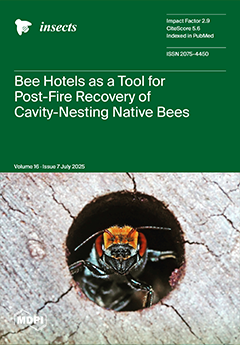Priophorus fulvostigmatus, a species of leaf-cutter wasp, is an important leaf-feeding pest on strawberries. We investigated the effects of temperature and soil moisture content on key life cycle parameters of
P. fulvostigmatus. The development time, survival, fecundity, and life table parameters
[...] Read more.
Priophorus fulvostigmatus, a species of leaf-cutter wasp, is an important leaf-feeding pest on strawberries. We investigated the effects of temperature and soil moisture content on key life cycle parameters of
P. fulvostigmatus. The development time, survival, fecundity, and life table parameters of
P. fulvostigmatus were observed at five temperatures. Pupal development and survival under five moisture contents (8%, 12%, 16%, 20%, and 24%) and four durations of water immersion (0, 1, 3, and 5 d) were recorded.
P. fulvostigmatus could complete its life cycle at a constant temperature range of 16–28 °C. The duration of the immature stage first decreased and then increased with rising temperature, being longest at 16 °C and shortest at 25 °C. Female longevity and female fecundity did not differ between the temperature range of 16–25 °C. However, survival rates at all developmental stages decreased with increasing temperature. At 28 °C, both fecundity and survival rates of
P. fulvostigmatus were significantly reduced compared to other temperatures. Compared with that at the constant temperature of 22 °C, the developmental duration of each stage was similar at a fluctuating temperature of 22 °C. The number of eggs laid per female, the longevity of male adults, and the eclosion rate were all significantly reduced. The net reproductive rate (
R0) under constant temperature conditions was significantly higher than under fluctuating temperature conditions, and the mean generation period (
T), intrinsic rate of increase (
r), and finite rate of increase (
λ) differed significantly. The soil moisture content significantly impacted the pupation and eclosion of
P. fulvostigmatus. Differences in soil moisture content had no significant effect on the duration of development; a moisture content of 8–16% was more suitable for their pupation and eclosion. Pupal development differed significantly between different periods of water immersion after the mature larvae were immersed in the soil. The longer the larvae remained in the soil, the lower their emergence rate after immersion. Thus, environmental temperature affected the growth, reproduction, and survival of
P. fulvostigmatus. The optimal soil moisture for pupation of mature larvae was 12% to 16%. After the larvae were immersed in soil, the emergence rate was significantly reduced. These findings expand our understanding of the biological characteristics of
P. fulvostigmatus and can facilitate the development of prevention and control strategies.
Full article






